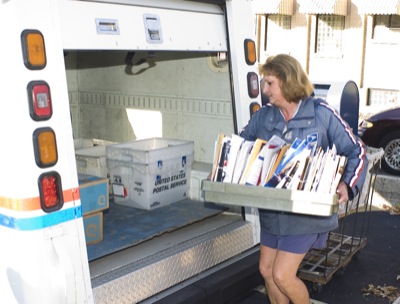Thursday, October 22nd, 2009
Mail service looking for ways to cut costs
By Janie Southard

Photo by Mark Pummell/The Daily Standard
Celina postal worker Sandi Highley loads mail Wednesday morning in preparation for her delivery route.
Distribution of local mail could shift from a Lima facility to Toledo if a U.S. Postal Service study finds consolidation feasible. Some area postal union employees are already out with signs to keep the processing/distribution center in Lima.
In a recent letter to this newspaper, Laura Kessen, president of the Lima chapter of the American Postal Workers Union, called any consolidation with Toledo a "misguided cost-cutting scheme" that will "likely result in slower, less reliable service" for the entire 458 zip code area. She cited a number of delays in all classes of mail involving paychecks, medication, bill payments, newspapers, packages and more.
She compared Lima's one-day delivery standard for mail to Columbus, Dayton and Fort Wayne against Toledo's two-day standards for those areas.
But David Walton, spokesperson for the U.S. Postal Service, said there will be no delays.
"We deliver mail hundreds of miles every day. There would be no problem in a one-day turnaround using Toledo if the consolidation actually ever comes to be and that has not been determined," Walton said Tuesday.
The U.S. Postal Service is doing 30 to 40 area mail processing studies (consolidation feasibility studies) across the nation right now, he said.
"Some studies have already been halted because we discovered early that consolidation would not be efficient or cost saving for us. The Lima/Toledo study has just begun," Walton added.
The U.S. Postal studies are evaluating 371 locations nationwide as to efficiency in use of space, staffing, equipment and transportation. Walton said the study is looking at such things as number of hours to process the mail, the machinery used for the entire shift and are trucks half full.
In 2006 Congress generated legislation allowing the postal service to make a profit. Prior to that the best the service could do, by law, was to break even and it hasn't done that in a couple years.
Revenue has been adversely affected for several reasons. One is the Internet, which has become the main bill-paying and social communication vehicle for millions of people nationwide.
"And the economy is also a big factor. Businesses have had to make budget cuts in advertising and that's had a big impact on us," Walter said. "In 2008 we lost 24 billion pieces of mail in all postal classes. This year we had anticipated about 9.5 billion pieces lost, the same as anticipated in 2008, but we already know it will be more than 20 billion pieces."
Another factor playing into the consolidation study is improved mechanization.
"In 1999 it took 70 employees to process 35,000 letters in an hour. Now it takes only two employees," Walton said. "But, please note, we have 355 processing plants in the country with declining numbers, and we have never laid anyone off."
For a while there was talk of closing post offices nationwide on Tuesdays. In fact, the postmaster general requested Congress in January approve a five-day week for mail delivery.
"That alone would save $3.5 billion per year. But it would take an act of Congress because the law mandates six days per week delivery," Walton said.
So far the request appears to have stalled.
Should the Lima center move to Toledo, the work at local post offices would not change, Walton said. Zip codes would not change and local postmarks would continue to be available at local post offices.
From beginning:
The nation's postal service evolved from George Washington's idea that a free pathway of information between citizens and government would be the "cornerstone of freedom." That plan entailed a network of postal roads and post offices, which finally became the nation's postal service in 1775.
A government information Web site says this came about in no small part to Publisher William Goddard's idea, circa 1774, of developing a national postal service to put newspapers into citizens' hands and bypass the British postal inspectors. Congress finally bought into his idea and named Benjamin Franklin as postmaster general.
The first authorized postage stamps went on sale in New York City in 1847. Franklin was on the 5-cent stamp and Washington, who has appeared on more U.S. stamps than any other person, was on the 10-cent stamp.
Up until the Postal Reorganization Act of 1970, the postal service was an agency of the federal government and supported, of course, by taxpayers. Subsequent law made the service a semi-independent federal agency, which must maintain "revenue neutrality," which means no profit, just break even.
The Postal Act of 2006 permitted the service to compete for profit in the marketplace. It is now supported by postal products, such as stamps and services that customers purchase including package shipping.
- Janie Southard

